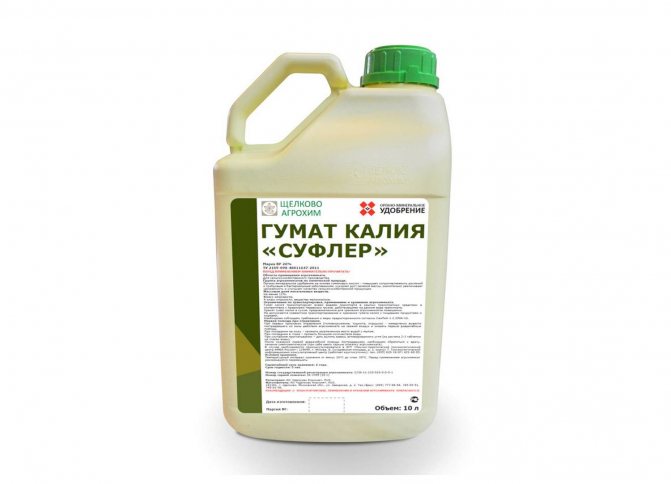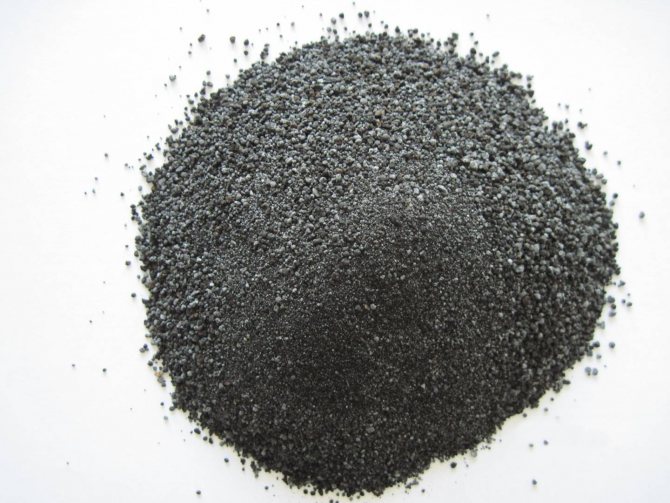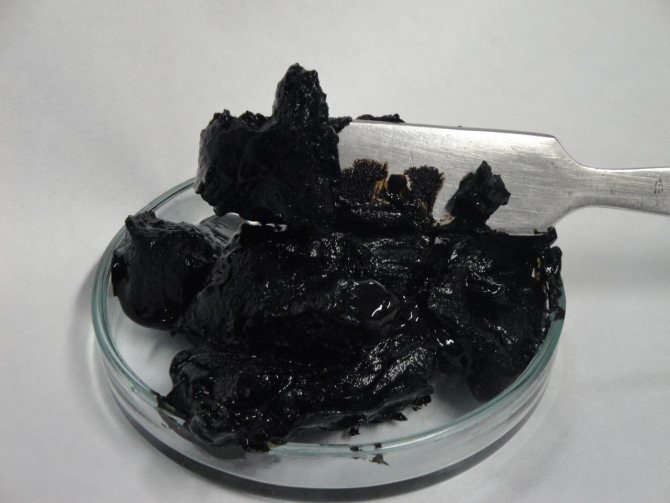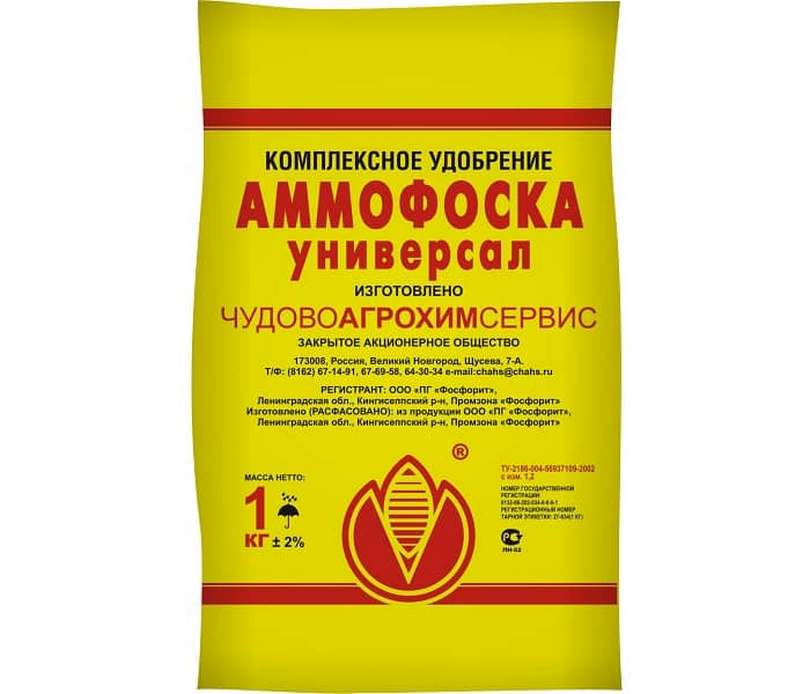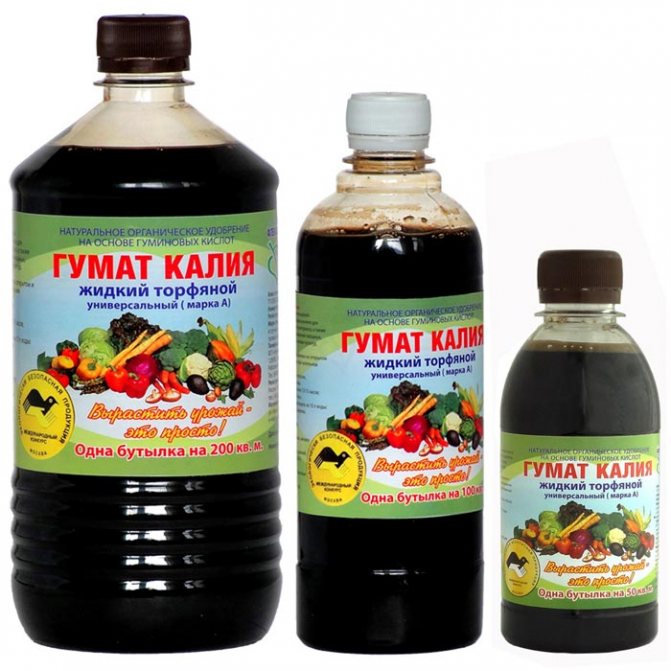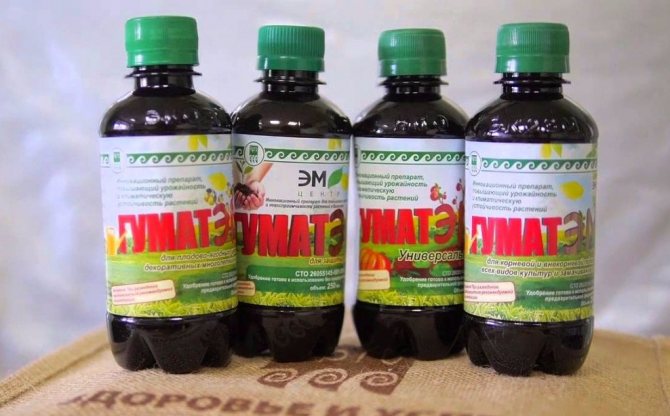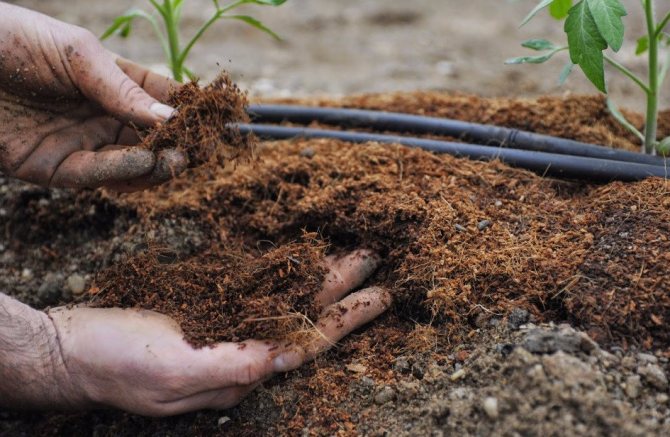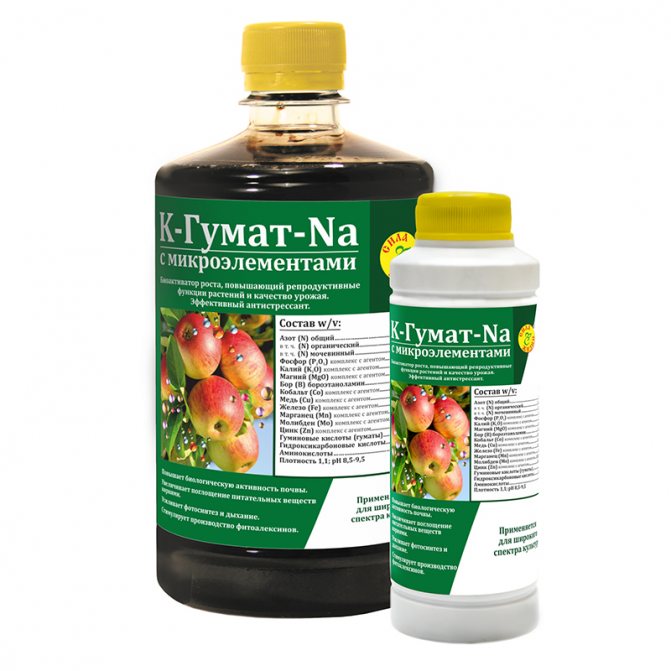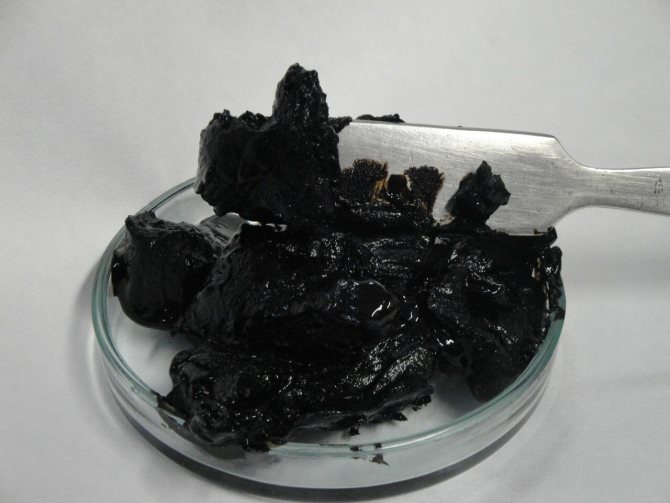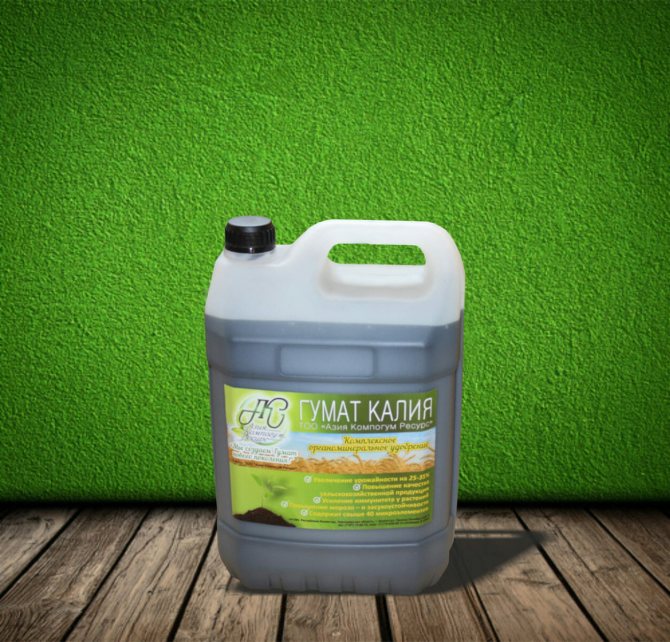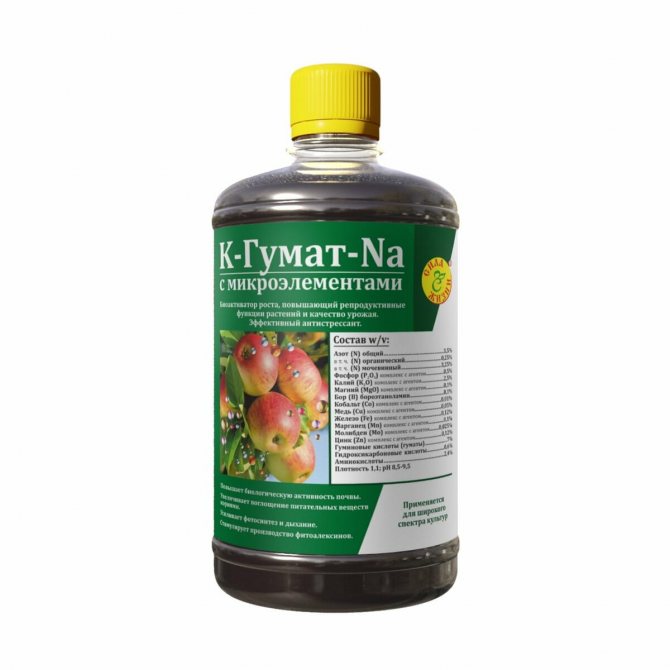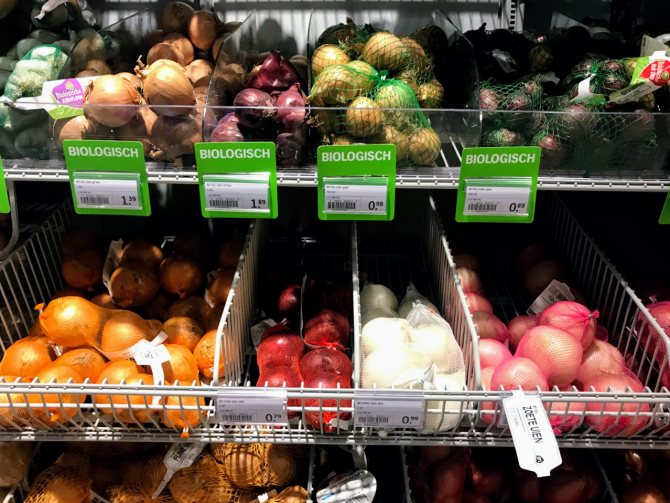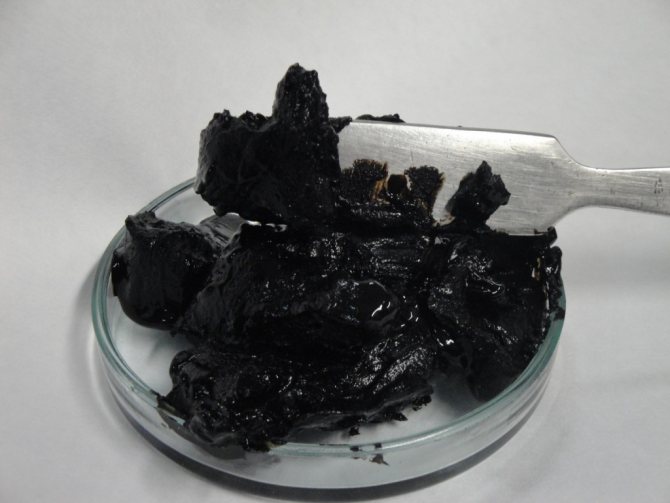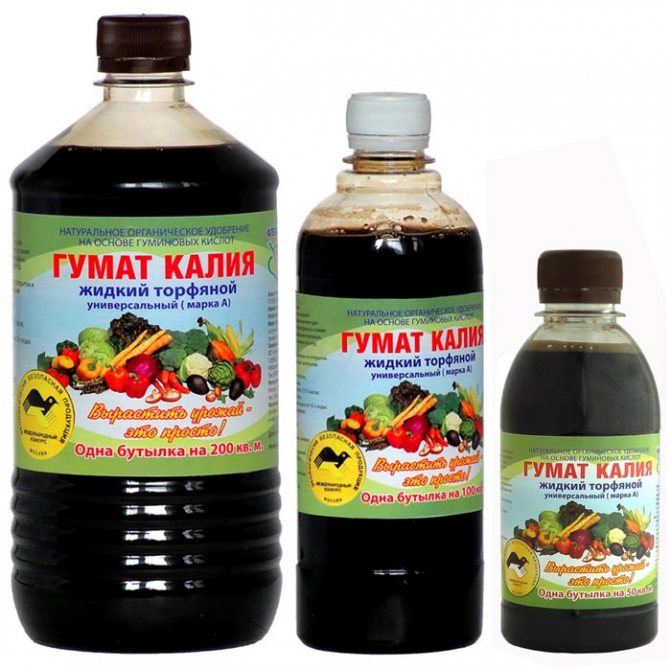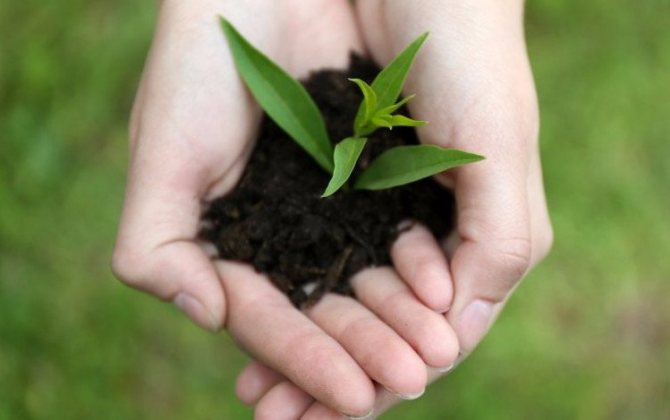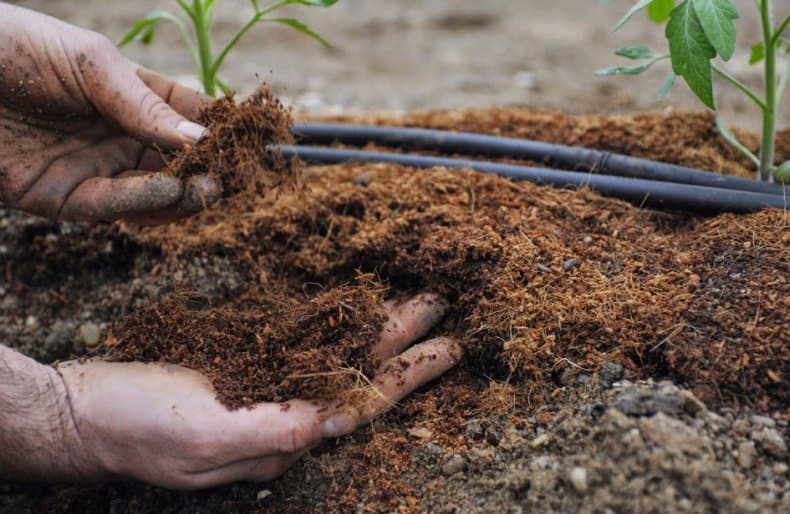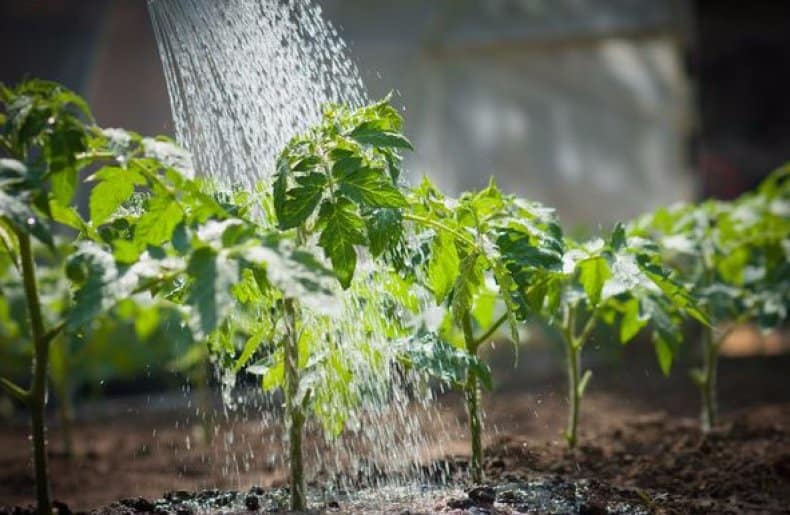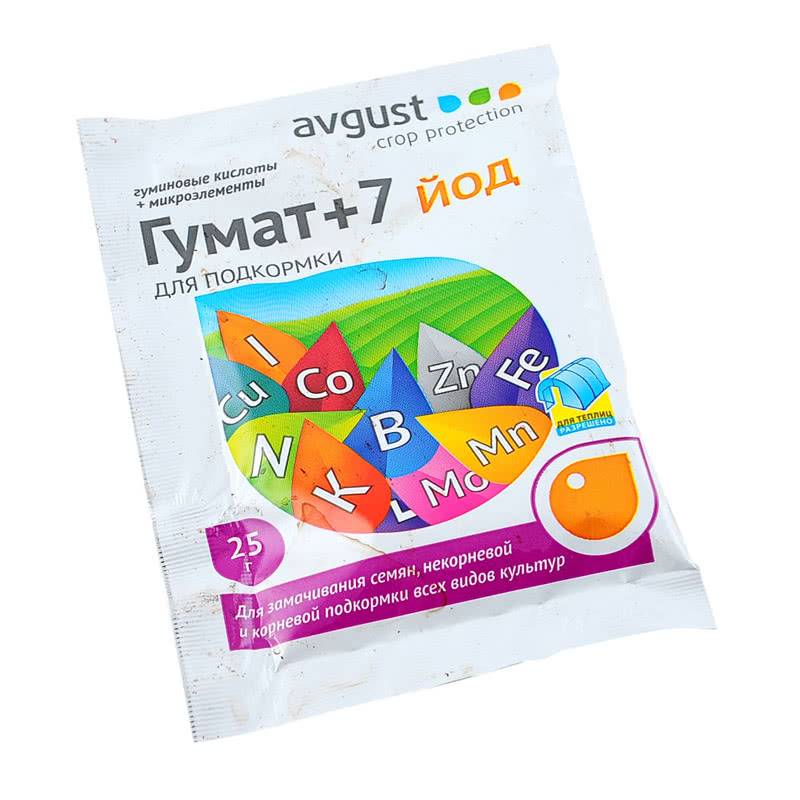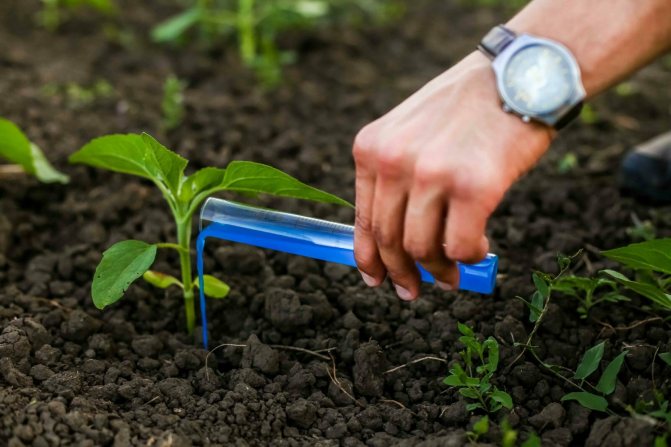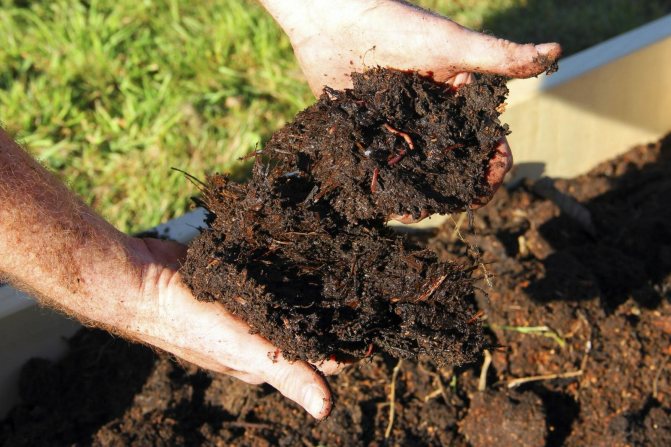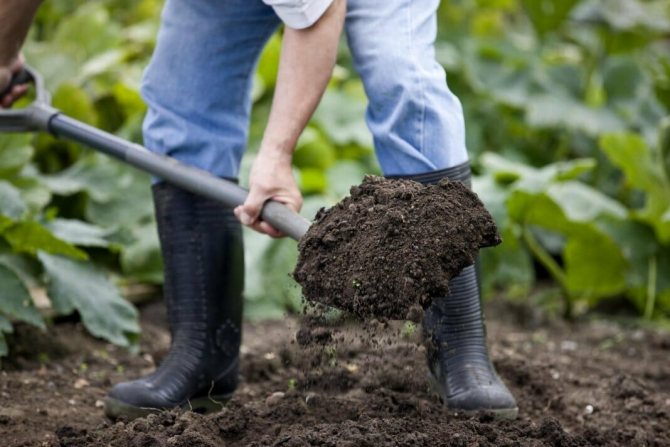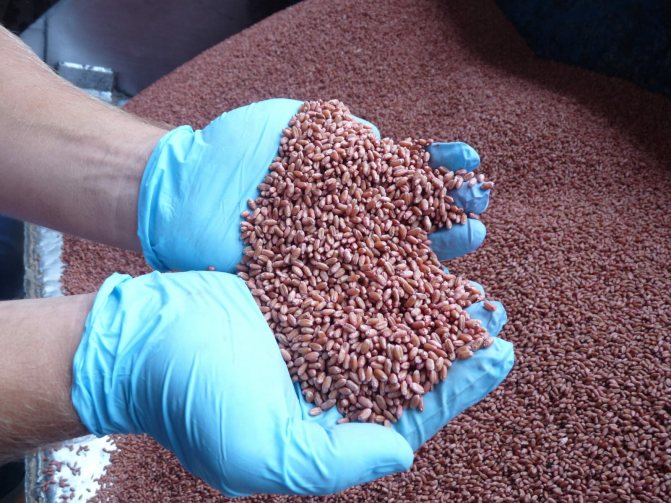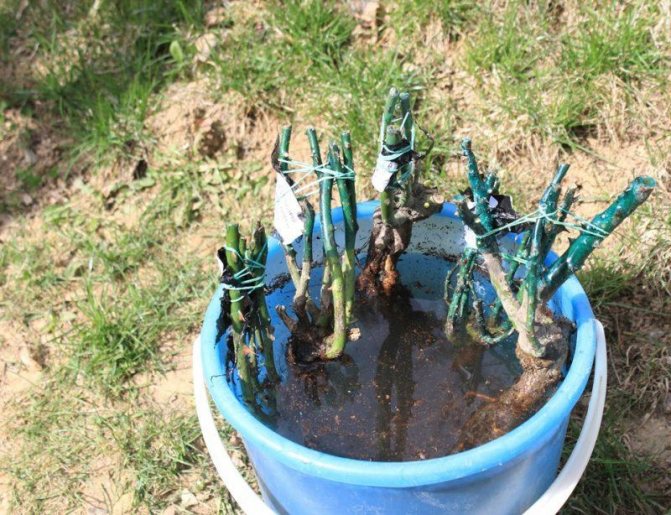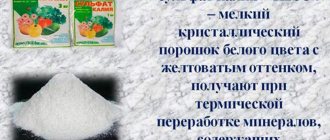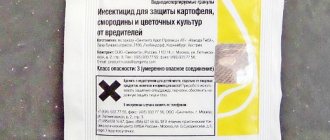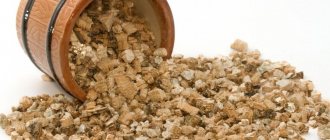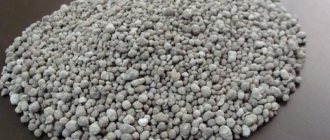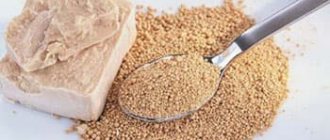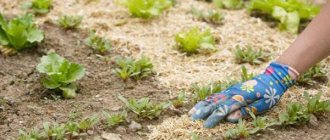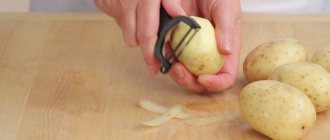Sodium humate is a mineral and organic fertilizer considered to be one of the best growth stimulants for vegetable and fruit crops. Many gardeners note that its use has a positive effect on indoor plants and garden flowers. Humate is widely used in plant growing, does not exhibit toxicity, does not possess cumulative properties and mutagenicity.
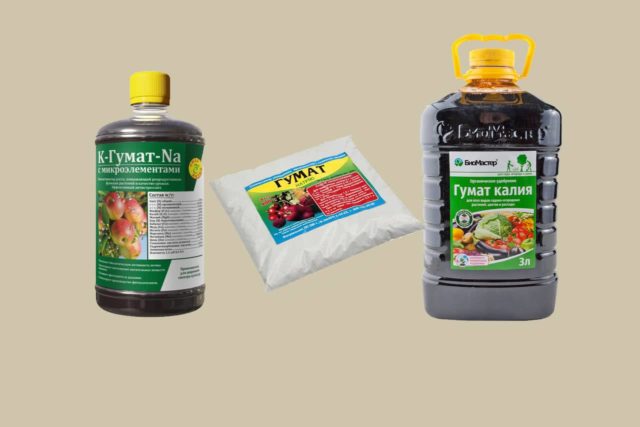
The substance exhibits high immunostimulating and adaptogenic qualities
Description, composition and mechanism of action of potassium humate
On sale you can find a variety of products called Potassium Humate. This does not mean that only one among others is natural, and the rest is fake.
Differences in shape, composition depend on the method of making the fertilizer: natural or artificial ingredients.
All types of humate (with microelements or dry, in the form of a tablet) are substances with humic acids (over 81%).
Amino acids, peptites, antibiotics and stimulants, enzymes make up the percentage. The ratio of additional substances is different for different manufacturers, in the form of release.
The mechanism of action is also not very different: stimulation of metabolic and biochemical processes. Obtaining fertilizer from coal and peat. In some cases, from silt and certain types of soil.
The appearance of the fertilizer depends on the form:
- liquid - a natural substance obtained by processing peat;
- powder form - an artificially created drug;
- potassium humate with microelements: the second name is "Prompter". It is a universal remedy. It is more used as a top dressing, which can be used every 2 weeks for the entire growing season. Then the introduction of humate Prompter is reduced to 1 time in 1.5 months. Obtained from bottom sediments of reservoirs with fresh water (sapropel).
Interesting fact! Powder fertilizer potassium humate may well replace humus. If we draw the ratios, we get the following data: 1 kg of humate will be equal to 1 ton of humus. At the same time, fertilizer in any form will help remove nitrates and pesticides from the fruits.
Terms and conditions of storage of sodium humate
Liquid "Sodium humate" has a limited shelf life, which is only 30 days. During this time, the solution should stand in a dark container, in a cool, dry room that does not allow light to enter, out of the reach of children, separate from medicines and food.
The powder form of fertilizer should be stored in a dark place at a temperature not lower than -5 ° C, for up to 5 years.
A warning! If the storage rules are not followed, the product loses its useful qualities.
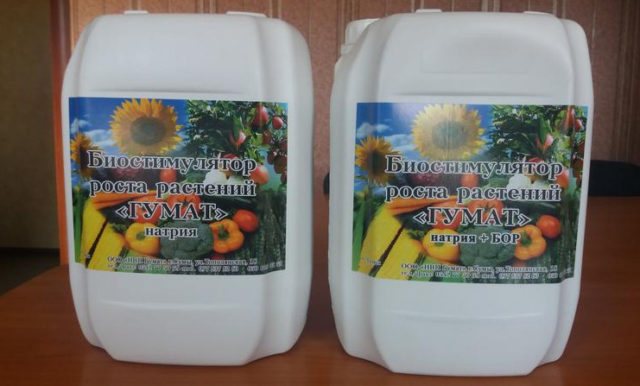

Fertilizer is not recommended for use on alkaline soils.
Differences from sodium humate
There is not only potassium humate, but also sodium. Two different substances that are obtained by treating humic acids with alkali. The treatment of plants with these fertilizers is identical. Then the question arises as to what is the difference between the two.
Differences - in the receipt of nutrients. If you feed with potassium humate, then the culture will receive potassium. The element is necessary for the full development and ripening of fruits. Fertilizer belongs to potash.
Sodium humate is used when there is an excess of potassium.Top dressing has negative and positive qualities (immunomodulator, stimulator of maturation and growth). In addition to the beneficial effect on the soil, plants, sodium prevents the entry and nutrition of crops with potassium. It also helps to increase toxins.
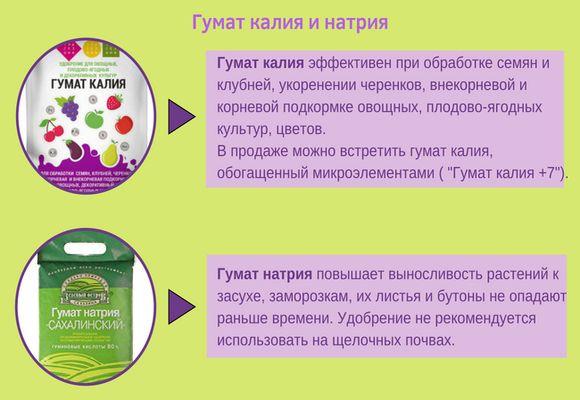

Since the substance is cheaper than potassium humate, gardeners often buy it. Considering the pros and cons of the two fertilizers, before buying, you should think about the harvest of the taste of the fruit.
Structure
Depending on the raw materials used, the composition of the fertilizer can be different - organic or organomineral. Focusing on this factor, humates are divided into two types - potassium humate and sodium humate. Both drugs are similar in their characteristics. Let's consider in more detail how their composition differs.
Potassium humate composition
Under the influence of this drug, the soil is saturated with useful elements that can increase the biological, chemical and physical parameters of the soil. Thanks to this, the yield of agricultural crops is increased, their growth is stimulated and the quality is improved.


This product belongs to organo-mineral fertilizers made from peat. In addition to the high content of potassium salts of humic acids, the composition of potassium humate is saturated with low molecular weight fulvic acids and amino acids. The high value of the drug is also ensured by the presence of active trace elements such as cobalt, copper, boron, molybdenum, zinc and manganese.
Potassium humate is characterized by neutral acidity and a wider sphere of influence, in comparison with sodium humate.
Sodium humate composition
It is a powerful plant growth stimulant. Under its influence, the number of shoots increases, the immune resistance to diseases and negative climatic factors (drought, high humidity, cold snaps) increases. The drug exhibits high adaptogenic and immunostimulating qualities.
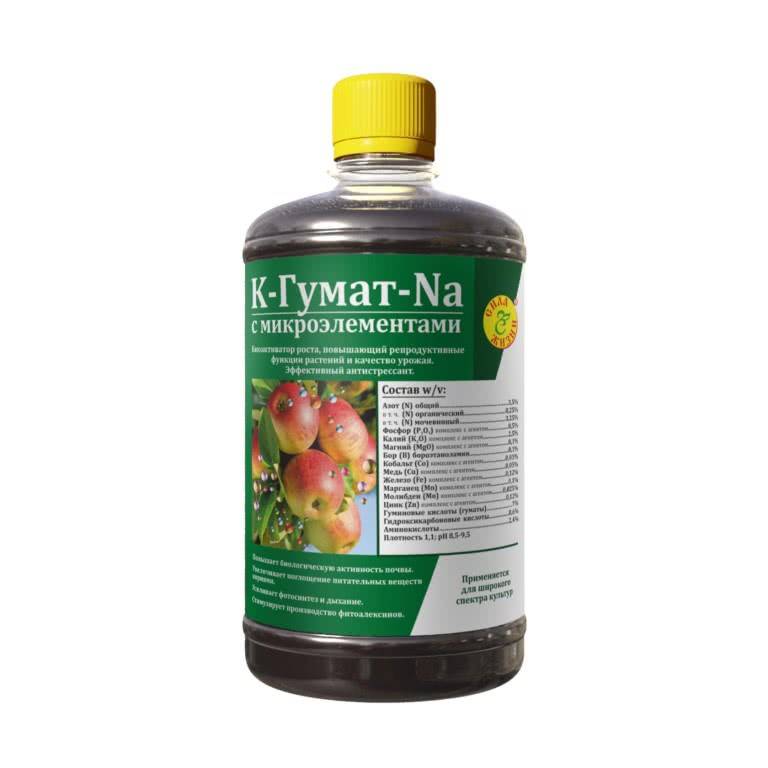

Sodium humate is made from peat, less often from brown coal. The high content of PH humate makes it highly effective on alkaline soils. The drug prevents premature fall of leaves and ovaries. In plant growing, it is widely used both in liquid and dry form. The stimulant is non-toxic, non-mutagenic and non-cumulative.
The composition of sodium humate includes sodium salts of humic acids (in the substance there are 70% of them). From trace elements it includes molybdenum, copper, cobalt, manganese and zinc. Heavy metals are lead and cadmium. The dry composition contains nitrogen, phosphorus, potassium, magnesium, calcium.
Fertilizers
Potassium humate is one of the universal fertilizers. At the same time, it is effective, economical in use. When compared with other popular organic matter (manure, humus), then in addition to the positive effect on the soil and plants, the following points are distinguished:
- environmentally friendly product;
- convenient for storage;
- quickly affects the culture;
- there is no need to wait for readiness time, as is the case with humus;
- does not have a strong unpleasant odor.
Before feeding the plants, it is worth deciding on the form of fertilization. But the choice is made by the farmer himself. They take into account the degree of necessity, terms, how convenient the method of application is, goals, and the expected result.
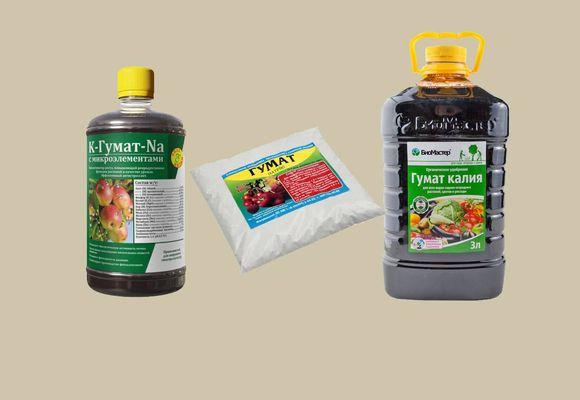

Liquid
Since the substance is obtained from peat, the color is dark brown. This form is the most popular. It is famous for its high efficiency, fast action on seeds and seedlings. Potassium humate is a concentrated liquid that is diluted in cold water before use.
Bottles of the substance have dilution instructions. Also, this form, unlike others, can be used together or sequentially with nitrogen-containing and organic fertilizing.
Powdered
Farmers are more characterized as an immunomodulator.The plant after treatment with dry potassium humate grows faster and bears fruit.
Positive changes take place in the soil (humus formation, acceleration of microflora recovery). Breeding. The scheme and proportions for preparation are indicated on the package with the powder.
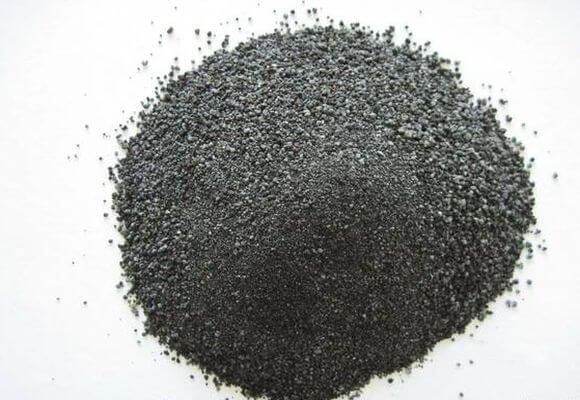

The most effective humic fertilizers
Each type has different characteristics and useful properties.
Potassium humate liquid peat
This product is dark in color. It is based on peat. An effective and sought-after growth stimulant. To get a positive result, you need to adhere to the dosage that is prescribed in the instructions. A liquid form of agricultural means helps to cope with diseases, stimulates growth, and increases yields. Combines with organic and nitrogen mineral fertilizers.
Potassium humate peat powder
Strengthens the plant's immunity, accelerates the growth and ripening of fruits and vegetables. It is not recommended to exceed the dosage indicated on the package, as this can lead to wilting of crops. It has a positive effect on the development of roots, microflora in the soil, increasing productivity. A kilogram of the product is compared with a ton of humus in terms of beneficial properties and effects on plants.
The drug "Reichard"
A balanced mixture that improves soil fertility. The composition includes only environmentally friendly and safe components. Suitable for open and closed ground, indoor plants, fruit and berry crops, vegetables. It is used when processing seeds, as well as during the entire growing season. Stimulates growth, protects against diseases, pests, increases the quality and quantity of the crop.
Fertilizer mixture "Prompter"
A unique product, as it contains a balanced formula of organic compounds and minerals. Accelerates seed germination, helps to resist diseases and pests. Improves soil composition.
Can be used 2 times a month from early spring to autumn. It is necessary to prepare the solution immediately before use (it is impractical to dilute it in a few days: the composition will lose its useful properties). It is not recommended to store it ready-made.
Areas of use
Potassium humate is a versatile organic product for planting. With its help, the gardener can start working with the land, planting material.
During the growing season, feed the crop until harvest. Before winter, it is also brought in so that the soil replenishes the lost supply of useful trace elements.
You can use humate:
- during preparatory work with seeds, seedlings. The introduction takes place in liquid form, that is, soaking is carried out;
- as a top dressing;
- after transplanting seedlings for better adaptation, rooting;
- for processing plants in open and closed ground at all stages of growth;
- for spraying during flowering. But the concentration of the solution should be low (maximum 0.1%);
- to improve the quality of organic nitrogen-containing fertilizers and soil reclamation.
The method of preparation and dilution of the working solution is indicated on the package. Step-by-step instructions will help prevent possible side effects.
Pre-sowing preparation
Potassium humate is often used as an immunomodulator. For this, the seed is soaked before planting in the ground.
The procedure promotes a percentage increase in the germination of seeds, bulbs, grains. Apply a diluted liquid concentrate. Soaking time from 8 hours to a day.
Growing seedlings
To improve immunity, potassium humate is applied to seedlings. The fertilizer does not lose its properties, the effect is manifested during the growing season.
When applied for seedlings, we get the following result:
- increasing resistance to infections, fungi;
- pest resistance;
- increased survival after transplanting into open ground;
- stable state under negative environmental influences.
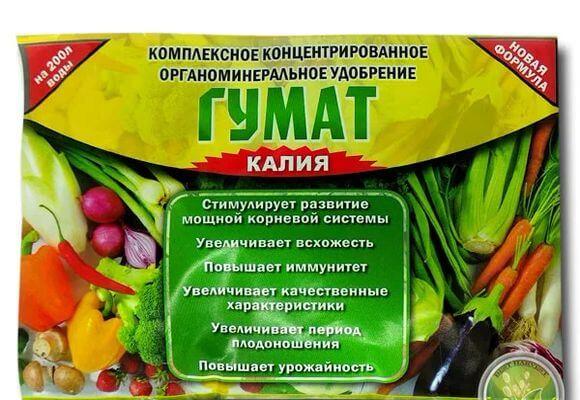

As a fertilizer
It is not necessary to wait for the disembarkation of seedlings in order to start feeding it. Embedding fertilizer in the soil for the winter or early spring will help perennial crops to "wake up" and take root faster for annual crops. Dry humate is chosen as a "saving drug".
For convenience, the powder is mixed with sifted river sand. Absorption into the middle and lower layers takes place during snow melting. If the winter is not very snowy, digging is carried out.
Useful properties of potassium humate for plants and soil
What is potassium humate used for? The most popular is the liquid form of the drug: it is better absorbed by the roots and shoots. Normalization of the exchange of useful compounds and accelerated protein synthesis will be observed.
After seed treatment with this growth stimulant, their germination and germination increase. The sprout will be healthy and strong. If you process seedlings or seedlings, then you will find better rooting and an accelerated process of survival. An adult plant develops faster, as a result, a high-quality crop is obtained above the norm by 15-25%. This humic preparation can be used to process peppers, radishes, eggplant, pumpkin, onions, tomatoes, cabbage, beets and carrots, as well as flowers and potato fields.
After processing the culture, its best adaptation to environmental changes is monitored in the future. The composition includes only environmentally friendly compounds that are not able to accumulate in a tree or bush, and are completely safe for the human body.
Potassium humate also has a positive effect on the soil, accelerating the formation of humus - the main component of the soil containing nutrients.
Advantages and disadvantages
Definitely, the benefits of potassium humate cannot be exaggerated. The product has a stimulating effect for all types of horticultural / horticultural crops. Its task is to have a beneficial effect on the roots of the plant, make it actively develop, strengthen.
Positive traits:
- suitable for all cultures;
- helps to increase resistance to diseases, infections, pests;
- endows with frost resistance, increases the storage period of the crop;
- reduces the need to obtain nitrates in fruits;
- increased germination, acceleration of fruiting times;
- ripening in general is accelerated to 10-14 days;
- the characteristics of the soil are improved. Accelerated recovery of microelements occurs;
- environmentally friendly fertilizer.
Only two nuances are distinguished by the negative sides of the application. The first is that you cannot apply if there is enough potassium in the soil. An excess of an element impairs the development of culture.
Second, strict adherence to dosages is required. No organic product can have a beneficial effect on the earth and plants in a concentrated form.
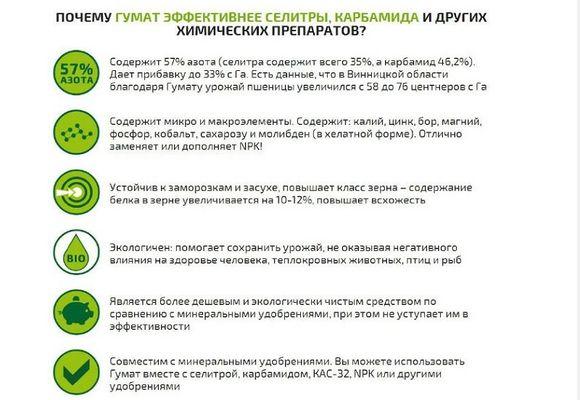

Form of preparation
Currently, sodium humate can be used both in liquid and powder form. Let's take a closer look at each type.
Liquid
This form is the most commonly used because it is very easy to use. It is made from peat and is very effective in use. This liquid fertilizer is dark in color and saturated with nutrients.
This drug can be combined with nitrogen-containing and organic fertilizers. It is quite simple to use - diluted with cold water. For soil processing, 0.1 - 0.2% of the total volume is needed, and in order to spray the plants, only 0.01% is enough.
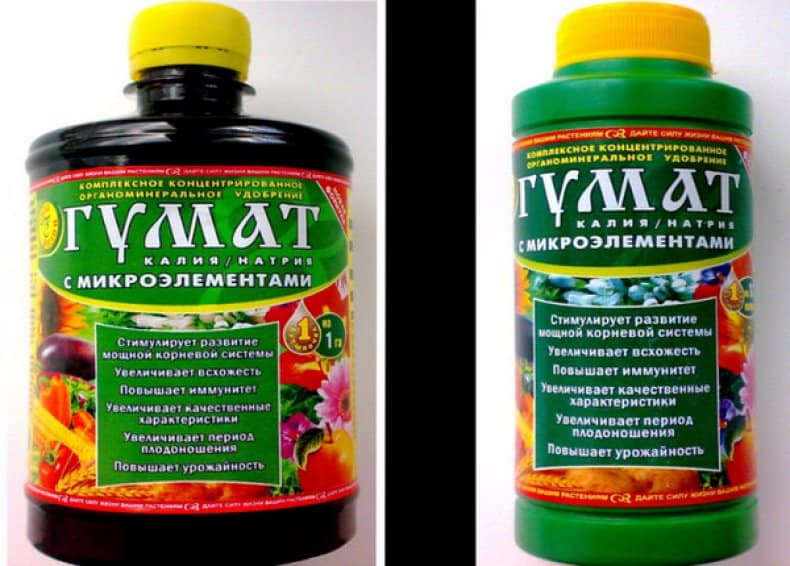

Powder
- This form is more suitable for enhancing the immunity of plants during the period of active growth and development. Promotes faster bud setting and fruit ripening. But the black powder, due to the sodium salts that are included in the composition, is rather poorly soluble in water.
- It is necessary to use and dilute the fertilizer clearly according to the instructions, since the product is concentrated in its pure form. If you need to process the seeds, then only 1 tsp is diluted in 1 liter of water. powder.
- To feed the soil in the autumn, use 1 tbsp. l. on a bucket of water. The advantage of fertilization is the ability to strengthen not only the root system, but also the aboveground part of the crop.
- The use of sodium humate powder activates the microorganisms and bacteria necessary for plants in the soil, which helps to grow a better crop.
- After processing, the soil is not only freed from harmful heavy metals, but also acquires a full range of nutrients and becomes more fertile.
How to prepare a working mixture
In 90% of cases, it is recommended to dilute potassium humate before use. Concentrated liquid product is harmful instead of good. The manufacturer's instructions provide for different dosage for dilution.
Depends on the type of culture, the need for the element, the state of the soil, the stage of development. If the solution is needed to soak the seeds, then it is enough to stir 0.5 g in a liter of water. Processing times vary from 8 to 48 hours.
Watering / spraying is also carried out according to different patterns. For root application, the ratio of substances is 1 tbsp. l. to 10 liters. (potassium humate is stirred in water). Spraying: a less concentrated solution is required (3 g of fertilizer per 10 liter bucket).
Often, liquid organic fertilizer is recommended for treating fruits after spraying with pesticides. This is how detoxification is performed. Ratio: 50 g powder + 50 g sand. The expense of the funds received is 10 sq. m.
Need to know! In addition to powder, tablets and concentrate, you can buy potassium humate in the form of a gel / paste. The drug is more expensive than others, but more effective. The composition contains the most active molecules, which ensures an increase in the percentage of penetration.
Release form
"Sodium humate" goes on sale in dry (powder, granules) and liquid form, less often in the form of gel and paste. Considering its application, it should be noted that initially it is a free-flowing substance that does not dissolve well in the soil. When used as a growth stimulant, it is better to give preference to the ready-made solution.
Liquid "Humates" are sold in dark bottles of different sizes. They are convenient to use in small areas, as a fertilizer for indoor plants, when you need a little substance that will be consumed slowly and gradually.
The dry concentrate is convenient because it can be applied to the soil both in diluted and in loose form. Usually used in fields and large farmland. Dry "Humat" accelerates the development of microflora in the soil and contributes to the formation of good humus. It is embedded in the ground in the fall. The drug is evenly distributed over the surface of the earth, then the site is dug up and watered. For convenience, the granules are mixed with sand.
The agent in the form of a gel or paste is diluted with water before use, which ultimately gives a large amount of fertilizer. In terms of the method of use and effectiveness, preparations in this form are similar to a liquid concentrate.
Important! It is necessary to start feeding the plants with “Sodium humate” with a small amount, gradually increasing it with subsequent treatments.
Instructions for using the ready-made solution
Potassium humate, regardless of the purpose, must be diluted according to the manufacturer's instructions. Recommendations apply separately for crops, species.
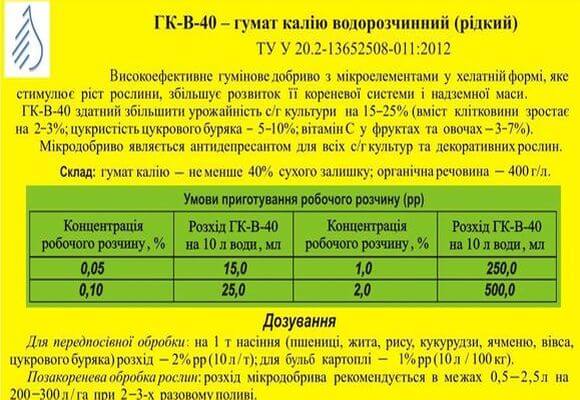

For cereals
It is up to the farmer himself to choose the method of application for grain crops. Recommended liquid concentrate for seed treatment and spraying. To use it effectively, it is suggested to dilute 200 ml of potassium humate in 10 liters of water.
The application depends on the growing season:
- first leaves, flowering - corn;
- budding, then after 2-3 weeks the procedure is repeated - buckwheat;
- tillering, first inflorescences - sorghum, millet, oats, barley, rye, wheat
For vegetable
In this case, top dressing (foliar, under the root) should take place taking into account the type of culture:
- for cucumbers and tomatoes, the standard solution (dilute 100 ml of potassium humate in 10 liters of water). Number of applications / treatments - up to 4 times;
- sheet for all vegetables (including tomatoes) 50 ml per 10 liters. Consumption depends on the age of the seedling (per 1 sq. M. From 3 to 10 liters);
- carrots, zucchini, cabbage and beets are processed 4 times per season with a standard solution.
How and for what purpose are humates used?
The use of humates is allowed in any industry related to the need to improve the quality of the soil. Humic acids are used in:
- gardening;
- growing grain crops;
- viticulture;
- growing vegetable crops;
- feeding indoor ornamental plants.
Humates belong to the category of hormone-like substances. With their help, pre-sowing seed treatment is carried out in order to increase their survival. Regardless of the type of humates, the method of their use is the same.
Seed treatment
Before proceeding to the treatment of seeds with humates, it is necessary to prepare the latter according to the instructions. Humates are sold in the form of a powder, from which a solution is prepared when the substance is diluted with water. Standard ratio of components: one tablespoon of humates per 10 liters of water. If pre-sowing seed treatment is carried out, the components are mixed in a different ratio: 0.5 grams of humic powder per 1 liter of water.
It is recommended to harvest humates with a surplus using a 2-liter plastic bottle. Such a container will require 1 gram of the active substance. It is recommended to use a teaspoon for dilution. 1 gram of humate is a third of a teaspoon.
When using liquid humates, the solution is prepared by diluting 100 milliliters of the active substance in 1 liter of water.
Treatment of seeds in humic acid is carried out by the soaking method. The duration of the procedure is two days. After that, the seeds are taken out and left to dry. When they are dry, they can be planted.
If processing of seeds of cucumbers or flowers is carried out, the soaking period is no more than a day.
You can learn more about how to prepare humates for processing seeds and plants at home by watching this video:
Plant feeding
Ballast humates are used for plant nutrition. The use of humic salts for this purpose is carried out in two ways: root and non-root. The root method involves standard watering. A tablespoon of humic powder is diluted in 10 liters of water, after which the necessary plants are watered with the mixture.
Foliar feeding is carried out by spraying. For such use of humates, a weaker solution is required. For 10 liters of water, you need 3 grams or one teaspoon of humic powder.
Top dressing is carried out during the growing season or fruiting. If the plant does not bloom, or it does not have buds, it is not recommended to use humates. Also, top dressing cannot be carried out if the harvest is scheduled no later than three weeks.
When feeding with humates, a number of rules must be observed:
- for one square meter, at least 3 liters and not more than 10 liters of solution are used;
- during the growing season, plants are sprayed from 2 to 6 times;
- for feeding beets, cabbage, zucchini, carrots, spraying with potassium humate 4 times during the season;
- processing of fruit and berry plants is carried out together with pesticides and herbicides during the formation of fruit ovaries;
- feeding of garden flowers is carried out in the spring no more than 6 times within two weeks;
- indoor plants are processed once every 15 days from March to September.
If liquid humate is used, the solution is diluted by mixing 50 to 100 milliliters of active substance per 10 liters of water. After that, the mixture is poured under the root of the plants, taking into account the use of 3 to 10 liters per 1 square meter.
Tillage
Only powder-type humates are intended for soil cultivation. The purpose of this use of humic salts is to detoxify and improve the structure of the soil. The substance is pre-mixed with sand, after which it crumbles to the surface of the earth. To process 1 square meter of soil on the site, 50 grams of powdered humate is required. After all the necessary territory has been cultivated, the land must be loosened so that the substance better penetrates the soil.
The procedure must be carried out in the spring before planting the plants, and in the fall after harvesting. Beneficial substances are gradually washed out under the influence of precipitation and irrigation, as a result of which the quality of the soil deteriorates. If you do not use potassium and sodium humates, there will gradually be a lack of magnesium and iron in the soil.
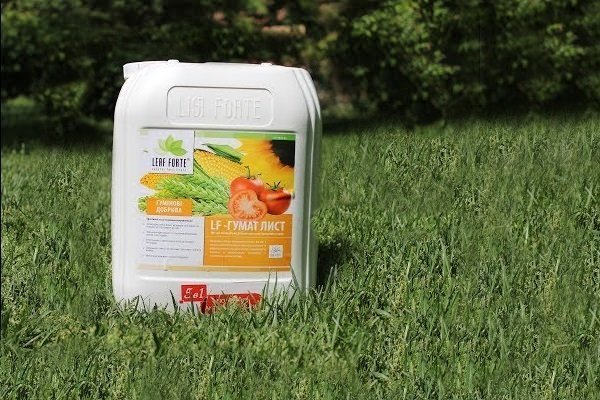

The specified rate must not be exceeded - an excess of humic salts in the soil can cause a negative reaction.
How are humates with manure and compost applied?
The use of humates together with manure and compost has a number of advantages:
- acceleration of the process of plant development;
- reducing the minimum required rate of humates for soil cultivation by 2-3 times;
- the efficiency indicator of humic salts does not decrease;
- harmful bacteria and microorganisms contained in the manure are destroyed;
- the level of ammonia in the compost is reduced to a minimum.
To prepare the fertilizer, the components are mixed in the ratio: 10 grams of humates per 10 kilograms of manure. Humic acids are best mixed with mullein. The process of applying humates with manure and compost is as follows:
- fertilizer preparation is carried out no later than 2 months before its use;
- a standard solution is prepared from humic powder, with which the mullein is poured;
- manure is thoroughly mixed for high-quality decomposition;
- before use, the mullein is dissolved in water in a 1 to 1 ratio and infused for 2 weeks;
- the resulting substance is again mixed with water in a ratio of 1 to 10, after which it is poured under the plants.
It is recommended to treat the soil with humates with manure in the evening. Such a substance should not be poured directly under the root of the plant. Between the beds or next to the bushes, grooves are drawn where fertilizer is poured.
Fertilizer compatibility
The farmer at the beginning of the season creates his own calendar of treatments, field work with plants. At the same time, treatments with fertilizers, fungicides and other means are charmingly taken into account. If during the growing season it is decided to apply potassium humate, then:
- It is impossible to process the soil together with phosphorus-containing preparations, potassium nitrate. The gap between applications can be at least a week.
- Perennial crops are processed several times per season. But annual plants - only before the beginning of budding.
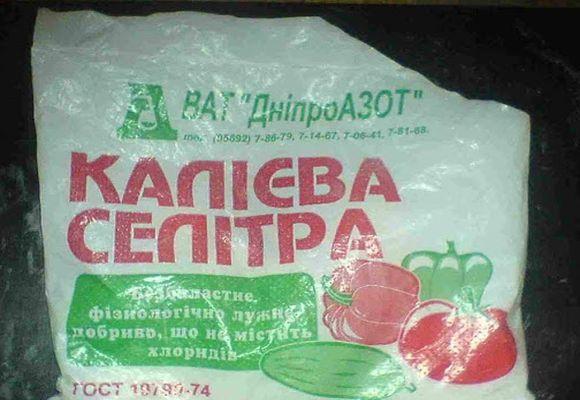

Application methods
The method of using humic fertilizers can be applied depending on weather conditions, soil conditions, and the appearance of plants. Gardeners prefer watering more, since useful components penetrate to the roots faster.
It is possible to dilute concentrated humates with water and spray the aerial part if there is a lag in the set of green mass. With this method, the treatment is carried out in the evening so that the sun's rays do not provoke leaf burns. After foliar spraying, the processes of chlorophyll synthesis and nitrogen absorption are activated.
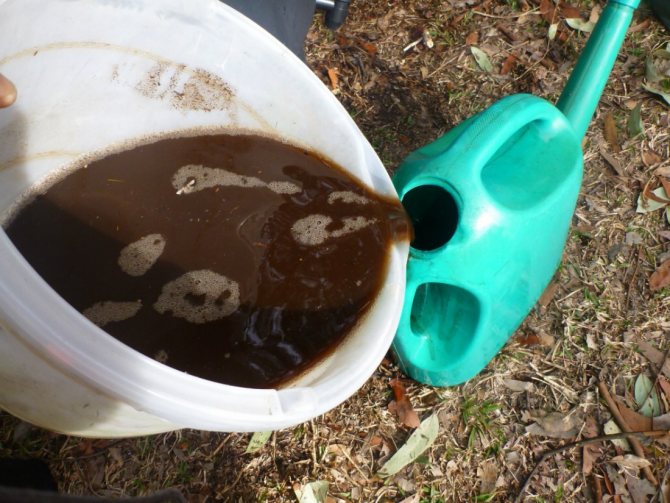

Important! When feeding with humates, the amount of nitrogen fertilizers can be reduced by 50%
Through the leaf plate, useful components quickly penetrate into tissues and are absorbed.
Embedding dry matter into the soil is used in autumn. It is evenly distributed over the beds and dug up. After that, it is advisable to water the area well. Sodium and potassium humate can be applied simultaneously in the spring, a week before planting.
Potassium humate analogs
It is not necessary to purchase potassium humate. You can always use similar products that contain supplements in the form of minerals. Gumat + 7 iodine has proven itself well. Also offer:
- Gibbersib is a phytohormonal substance;
- Giteroauxin - growth activator;
- The athlete is a growth regulator;
- Gumfield is a stimulant.
Each drug has beneficial properties, special rules of use. Before starting work, be sure to study the instructions for use, dosages and expiration dates.
What are humates?
Humates are natural elements formed in the soil during the breakdown of plant cellulose. They are also known as humic acids. These elements are classified as salts based on sodium or potassium. For garden crops, humates replace fertilizers.
Humic acids are formed when they break down:
- peat;
- brown coal;
- sapropel;
- leonardite.
Among the listed elements, the smallest amount of humates contains coal. The volume of humic acids from the total composition of solid fuel is 5%. The easiest way to get humates is from leonardite. This component contains from 40% to 80% humic acids.
The first humates were created 60 years ago. The author of the study, as a result of which these elements were obtained, is Professor Lydia Khristeva. It was she who determined the beneficial properties of humic acids.
When humates enter the soil:
- stimulate the work of microorganisms;
- improve the structure of the soil;
- promote the penetration of water and oxygen into the ground.
This improves the quality of the soil, which enhances plant development and increases yields. Humates do not contain substances that are dangerous to the environment, due to which they can be used in any conditions.
Scope of application
A preparation based on natural ingredients is used for:
- increasing the concentration of humus in the soil;
- preventing the accumulation of harmful chemicals in the ground;
- activation of beneficial microflora;
- better and faster rooting of young seedlings;
- reducing the use of agrochemicals;
- shortening the ripening period of fruits;
- increasing the nutritional and energy value of the crop;
- prolonging the shelf life of fruits without losing taste and marketability.
Fertilizer sodium humate can be used to feed plant organisms in spring and autumn. Horticultural crops, including roses, have a strong root system after spraying them with an organomineral complex.
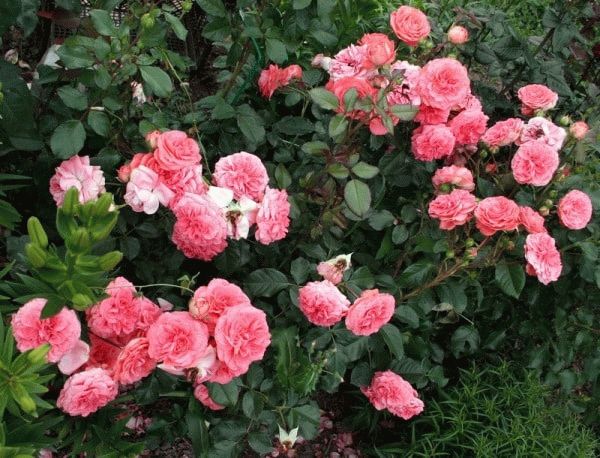

Tillage
After the application of sodium humate on the personal plot, the quality characteristics of the land are significantly improved and its detoxification is carried out. For these purposes, it is enough to scatter fertilizer at the rate of 50 g of the drug per 10 square meters. m area. It is more convenient to do this after pre-mixing the product with sand. At the end of the procedure, the soil must be loosened using a hoe or rake.
Another good tillage option is to spread a mixture of sodium humate, ash and sand over the snow (in spring). Such an agricultural practice will prepare the territory for the planting season.
After the snow melts, you need to cover this bed with a covering material and the earth will be ready for planting crops.
Composting
Several patents have been registered for composting using humines. They are used to treat plant residues to accelerate decomposition.
The green grass in the compost heap re-heats on its own, without requiring any processing.Only straw is moistened with the product, spraying from a fine-grained sprayer. It is better to grind the stems beforehand.
Then they make a mixture of straw, manure and irlite - a special clay that contains zeolite. The well-mixed mixture is stacked.
The technology allows you to quickly obtain high quality organic fertilizer. Irlit is a source of macro and micro compounds needed by plants. At the same time, it inhibits the seeds of dicotyledonous and monocotyledonous weeds that have fallen into the compost pile. The humus stimulator accelerates the decomposition of straw and manure, enriches the compost with nutrients, prevents putrefactive bacteria from multiplying, and lowers the acidity of the mass.
On summer cottages, where it is not possible to buy irlite, the compost is simply treated with a humostimulator solution before being added to the garden bed, filling a pack of powder with 10 kg of compost. The second method of application is to treat manure or humus with a liquid preparation before applying to the soil. For 10 kg of organic matter, 10 g of powder diluted with water will be required according to the manufacturer's instructions for the preparation.
What are humates for?
There are humates in the fertile layer of garden, garden, virgin land. These are potassium and sodium salts of humic acids and fulvic acids. They are formed during the decomposition of plant residues and are part of the humus.
Comment!
Humus is essential for soil organisms. It affects the metabolism of roots, participates in biochemical processes - oxidation, reduction, synthesis, resynthesis.
Scientists are studying the effect of humic acids on the soil-water-plant complex. In their opinion, they have a positive effect on the structure of the soil. They make it looser. Saturate the soil with oxygen. They increase the availability of nutrients, stimulate growth, improve the structure of water, and reduce the harm from toxic compounds (radionuclides, heavy metals).
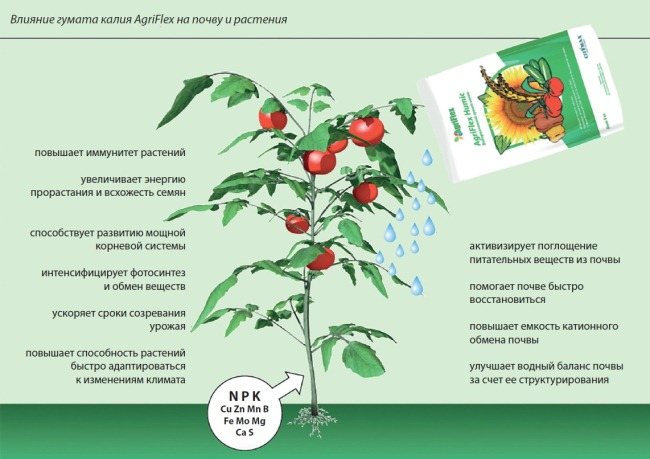

Even the ancient Egyptians, with the help of humic acids, increased the fertility of the earth. They used the silt of the Nile River. The concentration of acids in it is 2 g / l. The first industrial preparations containing humates began to be produced in the 30s of the XX century. Proponents of organic farming use humates to restore soil ecological balance, and grow ecologically clean vegetables.

